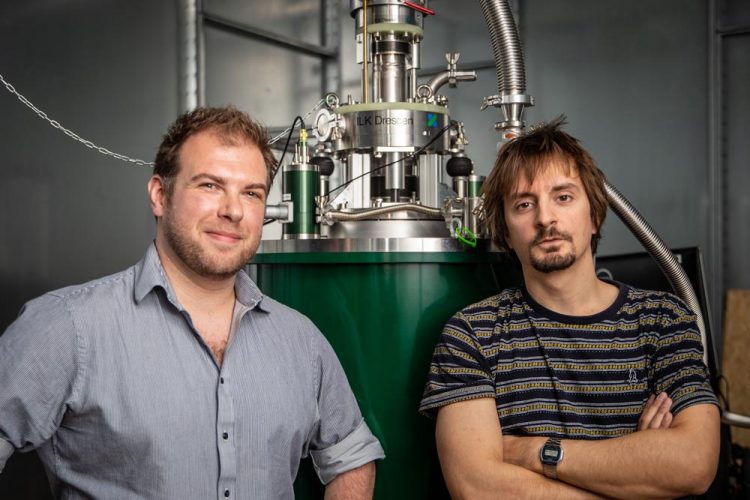Placing Another Piece in the Dark Matter Puzzle

photo/©: Dr. Arne Wickenbrock Dr. John W. Blanchard (left) and Antoine Garcon (right) in front of CASPEr-Wind-LF, which will cover the next frequency range for the CASPEr search
A team led by Prof Dmitry Budker has continued their search for dark matter within the framework of the ‘Cosmic Axion Spin Precession Experiment’ (or ‘CASPEr’ for short).
The CASPEr group conducts their experiments at the PRISMA⁺ Cluster of Excellence at Johannes Gutenberg University Mainz (JGU) and the Helmholtz Institute Mainz (HIM). CASPEr is an international research program that uses nuclear magnetic resonance techniques to identify and analyze dark matter.
Very little is known about the exact nature of dark matter. Currently, some of the most promising dark matter candidates are extremely light bosonic particles such as axions, axion-like particles or even dark photons.
“These can also be regarded as a classical field oscillating at a certain frequency. But we can't yet put a figure on this frequency – and therefore the mass of the particles,” explains Dmitry Budker. “That is why in the CASPEr research program we are systematically investigating different frequency ranges looking for hints of dark matter.”
For this, the CASPEr team is developing various special nuclear magnetic resonance (NMR) techniques, each targeted at a specific frequency range and therefore at a specific range of dark-matter particle masses. NMR generally relies on the fact that nuclear spins react to magnetic fields oscillating at a specific ‘resonance frequency’.
The resonance frequency is tuned via a second, usually static magnetic field. The fundamental idea of the CASPEr research program is that a dark matter field can influence the nuclear spins in the same way. As the Earth moves through this field, nuclear spins behave as if they would experience an oscillating magnetic field, thus generating a dark matter induced NMR spectrum.
In the current work, first author Antoine Garcon and his colleagues used a more exotic technique: ZULF (zero- to ultralow-field) NMR. “ZULF NMR provides a regime where nuclear spins interact more strongly with each other than they do with an external magnetic field,” says corresponding author Dr. John W Blanchard.
“In order to make the spins sensitive to dark matter, we only have to apply a very small external magnetic field, which is much easier to stabilize.” Furthermore, for the first time the researchers examined ZULF NMR spectra of ¹³C-formic acid with respect to dark-matter-induced sidebands, employing a new analysis scheme to coherently average sidebands of arbitrary frequency over multiple measurements.
This particular form of sideband analysis enabled the scientists to search for dark matter in a new frequency range. No dark matter signal was detected, as the CASPEr team reports in the latest edition of Science Advances, allowing the authors to rule out ultralight dark matter with couplings above a particular threshold.
At the same time, these results provide another piece of the dark matter puzzle and complement previous results from the CASPEr program reported in June, when the scientists explored even lower freuencies, using another specialized NMR method called ‘comagnetometry’.
“Like a jigsaw puzzle, we combine various pieces within the CASPEr program to further narrow down the scope of the dark matter search,” asserts Dmitry Budker. John Blanchard adds: “This is just the first step. We’re currently implementing several very promising modifications to increase our experiment’s sensitivity.”
Dr. John W. Blanchard
Helmholtz-Institute Mainz
55128 Mainz, Germany
phone +49 6131 39-29632
e-mail: blanchard@uni-mainz.de
www.blanchard-science.com
Prof. Dr. Dmitry Budker
Quantum, Atomic and Neutron Physics (QUANTUM)
Institute of Physics and PRISMA+ Cluster of Excellence
Johannes Gutenberg University Mainz
55099 Mainz, GERMANY
phone +49 6131 39-29630
e-mail: budker@uni-mainz.de
https://bukder.uni-mainz.de/
Antoine Garcon, John W. Blanchard, Gary P. Centers, Nataniel L. Figueroa, Peter W. Graham,
Derek F. Jackson Kimball, Surjeet Rajendran, Alexander O. Sushkov, Yevgeny V. Stadnik, Arne Wickenbrock, Teng Wu, Dmitry Budker “Constraints on bosonic dark matter from ultralow-field nuclear magnetic resonance”; Science Advances
DOI: 10.1126/sciadv.aax4539
https://advances.sciencemag.org/content/5/10/eaax4539
Media Contact
All latest news from the category: Physics and Astronomy
This area deals with the fundamental laws and building blocks of nature and how they interact, the properties and the behavior of matter, and research into space and time and their structures.
innovations-report provides in-depth reports and articles on subjects such as astrophysics, laser technologies, nuclear, quantum, particle and solid-state physics, nanotechnologies, planetary research and findings (Mars, Venus) and developments related to the Hubble Telescope.
Newest articles

An Endless Loop: How Some Bacteria Evolve Along With the Seasons
The longest natural metagenome time series ever collected, with microbes, reveals a startling evolutionary pattern on repeat. A Microbial “Groundhog Year” in Lake Mendota Like Bill Murray in the movie…

Witness Groundbreaking Research on Achilles Tendon Recovery
Achilles tendon injuries are common but challenging to monitor during recovery due to the limitations of current imaging techniques. Researchers, led by Associate Professor Zeng Nan from the International Graduate…

Why Prevention Is Better Than Cure—A Novel Approach to Infectious Disease Outbreaks
Researchers have come up with a new way to identify more infectious variants of viruses or bacteria that start spreading in humans – including those causing flu, COVID, whooping cough…



